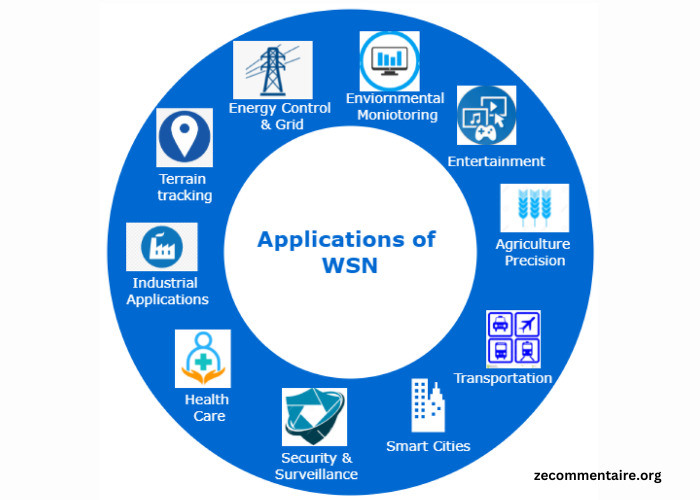The development of wireless sensor networks has allowed many significant improvements in embedded system design. A wireless sensor network (WSN) is a collection of spatially distributed autonomous devices that use sensors to collaboratively monitor physical or environmental conditions. Low-cost and low-power hardware development has enabled wireless sensor networks to become an active research field in a variety of fields, such as healthcare, agriculture, smart homes and cities, and industrial monitoring.
What is a wireless sensor network?
A wireless sensor network is a set of nodes that communicate wirelessly in order to collect information on the environment surrounding the sensors. The nodes include sensors, microcontrollers, transceivers, and power supplies. The sensor collects information, the microcontroller makes sense of the data, the transceiver sends it to secondary nodes or a central system, and the energy for each node comes from power sources. The nodes work together to deliver the data to a base station or sink, where information can be mined from it.
With the use of many sensor nodes, accuracy and coverage are improved in comparison to a single node. WSNs can operate independently in places without infrastructure or human intervention. They are more flexible and adaptable to the environment than wired systems. The main strengths of WSNs include fault tolerance, mobility, scalability, and self-organization.
Wireless Sensor Node Components.
- Sensors: These measure environmental parameters like temperature, humidity, pressure, vibration, motion, pollutants, and so on. Based on the application, different types of sensors can be integrated into a node.
- Microcontroller: This stores and processes sensor data. These include Atmel, PIC, and TI MSP430 series chips.
- Transceiver: This enables wireless communication in various networks, such as ZigBee, Bluetooth, Wi-Fi, etc. Common standards used are IEEE 802.15.4 and IEEE 802.11.
- Power source: Batteries, solar cells, or other energy harvesters can power sensor nodes. Energy efficiency is a major consideration.
- Memory: used to store data before transmission. Serial Flash or SD cards are popular options.
- Actuators: Nodes can contain actuators that respond to sensor data, e.g., turning on sprinklers when soil becomes dry.
The hardware components are integrated with embedded software for tasks like data processing, network protocols, and operating systems. The modular architecture allows flexibility in the node design based on application requirements.
Network Topologies for Wireless Sensor Networks
There are several standard topologies used to organize WSNs:
- Star topology: Each node directly connects to a gateway that relays data to other networks. Simple but creates a single point of failure.
- Cluster tree topology: Nodes connect in a hierarchy to cluster heads that aggregate data and connect to a gateway. Provides scalability.
- Mesh topology: Nodes connect directly with each other and cooperatively route data to sinks. Highly reliable but complex routing algorithms are needed.
The choice of topology depends on factors like scalability, coverage, cost, lifetime, and power needs. Hybrid topologies combine features of different architectures. The topology can be designed upfront or formed autonomously by the nodes upon deployment.
Key Design Considerations for WSNs
Several important factors have to be considered when designing embedded system wireless sensor networks:
- Power consumption: Nodes have limited battery life, so low-power electronics and energy harvesting may be used. Duty cycling nodes on and off can conserve power.
- Node size: Compact nodes allow easier deployment in environments like forests. Tradeoffs exist between size, battery life, and performance.
- Embedded operating system: Efficient OSs like TinyOS, Contiki, and RIOT provide programming abstractions while optimizing resource usage on nodes.
- Fault tolerance: Failures of individual nodes should not affect the network. Redundant nodes and robust protocols improve reliability and resilience.
- Scalability: The network should maintain performance and operation even with an increasing number of nodes. Hierarchical topologies and clustering help achieve scalability.
- Mobility: Protocols and algorithms must account for mobile nodes and changing topologies over time.
- Security: data encryption, access control, and authentication safeguard against attacks. Lightweight ciphers secure communication without much overhead.
These factors directly impact the cost, performance, and lifetime of the WSN and need to be carefully optimized based on application requirements.
Applications and Use Cases
Wireless sensor networks enable new applications across a variety of domains, including:
- Environmental monitoring: WSNs can monitor air and water quality, greenhouse gases, forest fires, natural disasters, and wildlife habitats. Dense node deployments over large areas provide high accuracy.
- Healthcare: Networks of wearable body sensors can track vital signs, physical activity, and medical conditions for improved care and telemedicine.
- Industrial monitoring: machine health, equipment faults, structural cracks, leaks, and other anomalies can be monitored to prevent accidents.
- Smart agriculture: monitoring soil moisture, crop growth environment, and livestock conditions optimizes yields, irrigation, and resource usage on farms.
- Smart homes and buildings: nodes can monitor occupancy, lighting, HVAC, energy usage, and automate applications such as temperature control, security systems, etc.
- Military: Battlefields, equipment, and enemy presence can be monitored by rapidly deployed mobile WSNs to enhance situational awareness.
- Traffic monitoring: vehicle counting, speed detection, traffic flow analysis, parking spot monitoring, toll collection, etc.
- Logistics: Nodes attached to pallets, containers, and vehicles track location, shock, temperature, humidity, etc. during transport.
Wireless sensor networks continue to find innovative applications in daily life. Emerging trends include integration with cloud computing, fog computing, IoT platforms, and pairing with technologies like AI and robotics. As hardware continues to advance and costs reduce further, the possibilities are limitless.
Conclusion
Wireless sensor networks enable sensing and monitoring applications in any environment without infrastructure. Recent advances allow dense, low-cost, and robust deployments of miniature but powerful sensor nodes. Efficient design by semiconductor design company ensures long battery life, reliability, security, and scalability. Standards enable interoperability between diverse components. In the future, emerging low-power technologies like 5G, Wi-Fi HaLow, and energy harvesting will address limitations and expand applications. WSNs have become indispensable for monitoring various environments and processes with a level of density and accuracy not possible previously. They will continue to play a pivotal role in shaping smart infrastructure and automated systems.
One emerging application of wireless sensor networks is in wearable technology and personal health monitoring. Networks of wearable body sensors can continuously measure vital parameters and activity levels and provide real-time feedback to users about their health and fitness. This can allow early detection of potential health problems and enable users to make positive lifestyle changes. Such personal WSNs may become as ubiquitous as smartphones in the future.





